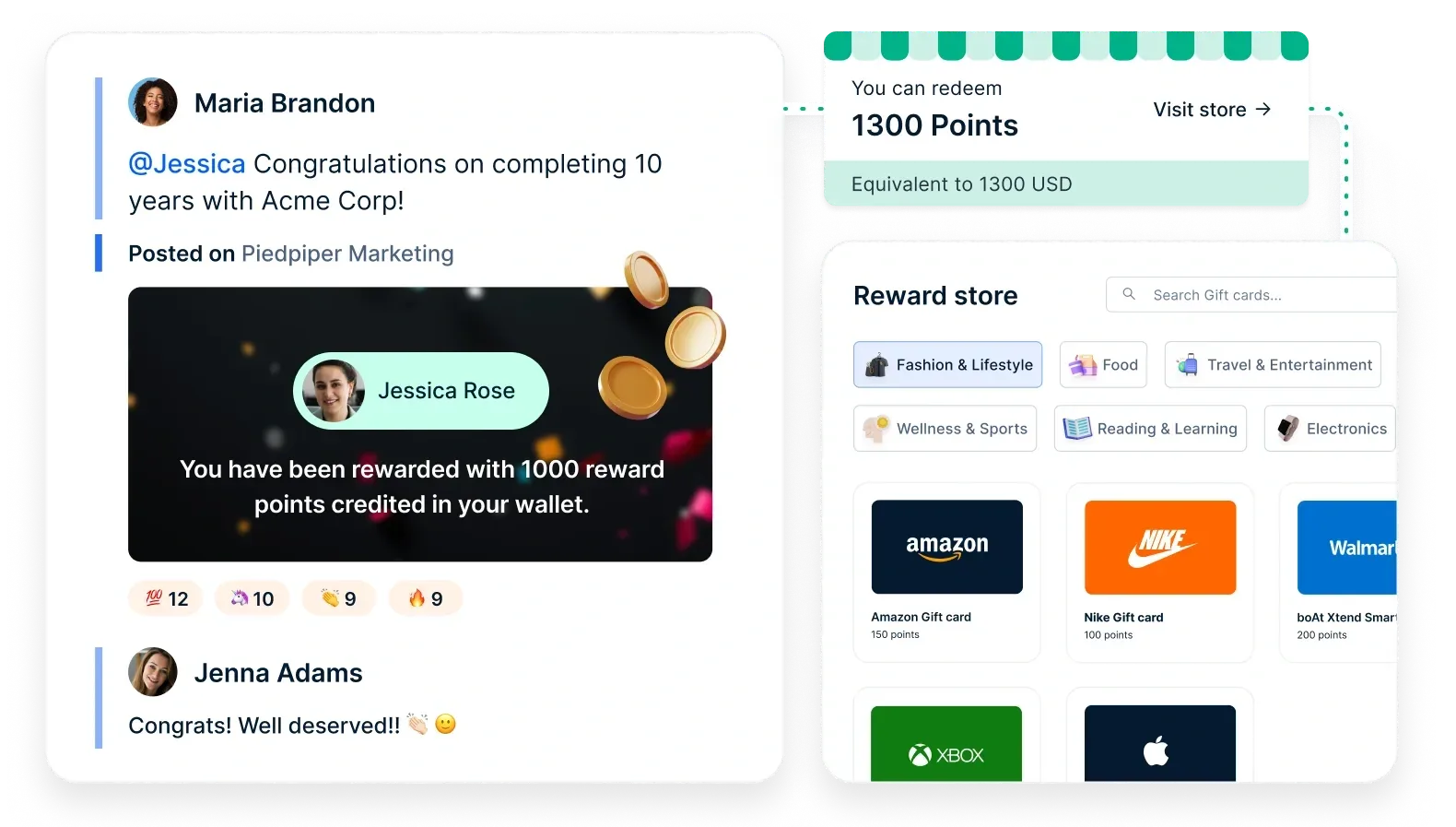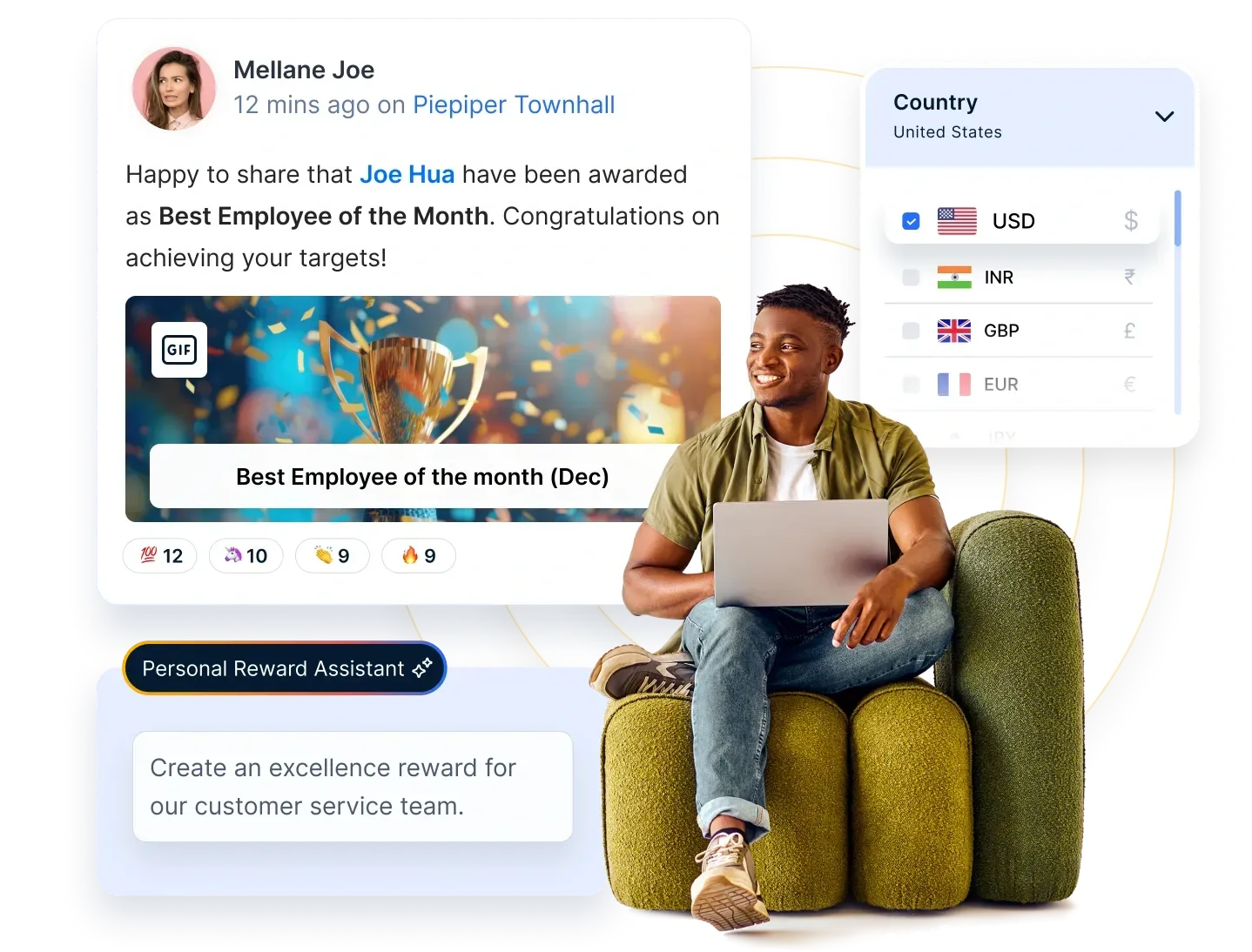Employee Engagement in the Retail Industry: 10 Strategies to Keep Their Shelves & Spirits High
Retail employees are crucial in shaping customer experiences and driving sales. However, high turnover and disengagement remain significant challenges in the retail sector. This blog explores engaging retail employees, enhancing motivation, and building a committed workforce.
In questa pagina
- The importance of employee engagement in the retail industry
- Common challenges in the retail industry
- 10 Strategies for engaging and motivating retail employees
- 5 Companies with amazing retail employee engagement strategies and lessons to learn from them
- Elevate Engagement for Your Consumer Goods & Retail Workforce with Empuls
- How Empuls transforms employee engagement:
- Conclusione
Retail employees are the driving force behind any successful store. As the first point of contact for customers, their performance directly impacts customer satisfaction, sales, and brand reputation. Prioritizing employee engagement in the retail industry is essential, as motivated employees are 31% more productive and contribute to a 37% increase in sales, according to a study by the World Economic Forum.
Since front-line retail employees represent the brand and influence overall shopping experiences, fostering retail employee engagement should be a top priority. Research from the University of Oxford highlights that motivated retail employees are likelier to go the extra mile, provide exceptional customer service, and stay committed to their roles.
However, the retail sector faces one of the highest employee turnover rates, often exceeding 60% in the U.S, with some estimates reaching 100% for part-time retail workers. To combat this challenge, businesses must focus on how to engage retail employees through recognition programs, career development, and continuous feedback.
In this blog, we’ll explore effective strategies to boost employee motivation in the retail sector, ensuring your workforce remains engaged, productive, and dedicated to driving business success. Whether you're a retail manager or an employee, you’ll find valuable insights to create a thriving and motivated team.
The importance of employee engagement in the retail industry
Employee engagement in the retail industry is critical for delivering exceptional customer experiences and driving business success. Engaged employees are more motivated, productive, and committed to their roles, leading to higher sales, better customer interactions, and improved team morale.
Prioritizing retail employee engagement helps reduce turnover, enhance operational efficiency, and create a positive workplace culture. Effective strategies such as recognition programs, career development opportunities, and regular feedback can significantly boost employee motivation in the retail sector.
Investing in employee engagement in the retail sector ensures a more satisfied workforce, stronger brand loyalty, and long-term business growth.
Common challenges in the retail industry
The retail industry faces several workforce challenges impacting business performance and employee satisfaction. From long working hours to high turnover rates, these issues can lower employee motivation in the retail sector and affect customer experience. A strong retail employee engagement strategy is essential to motivate teams, reduce attrition, and improve workplace productivity.
1. Demanding & long hours
Retail employees work in fast-paced, high-pressure environments, often standing for long hours while handling customer inquiries, stocking shelves, and managing transactions. The physical and mental strain can lead to burnout and disengagement. A well-structured employee engagement in the retail industry approach, including recognition programs, wellness initiatives, and flexible scheduling, can help motivate employees and improve retention.
2. Communication challenges
With retail operations spanning multiple locations, ensuring consistent training, clear communication, and seamless team coordination is a significant challenge. Frontline employees may feel disconnected from leadership, impacting productivity and morale. Investing in digital communication tools, regular check-ins, and structured feedback loops fosters retail employee engagement, keeping staff informed, aligned, and motivated.
3. High turnover rates
The retail industry is known for high employee turnover, driven by seasonal hiring, temporary contracts, and a lack of career growth opportunities. Constantly replacing employees affects team stability, training costs, and customer service quality.
Creating a culture of recognition, growth opportunities, and incentives can boost employee motivation in the retail sector, leading to a more committed and engaged workforce.
4. Customer expectations and service pressure
Retail employees must handle diverse customer needs, complaints, and expectations daily, requiring patience, problem-solving, and strong interpersonal skills.
Employees may struggle to maintain high service standards without proper support and motivation. Continuous training, performance-based rewards, and a positive work culture help employees feel valued, engaged, and motivated to deliver excellent customer experiences.

Empower Your Retail Employees with Recognition & Feedback
Retail success starts with engaged employees. Celebrate achievements, gather real-time insights, and create a motivated workforce with Empuls. Strengthen team connections and boost retention with a seamless engagement platform.
10 Strategies for engaging and motivating retail employees

Motivating retail employees is crucial for providing excellent customer service, improving sales, and fostering a positive work environment. Here are some tried-and-true retail employee engagement strategies to motivate employees and ensure they remain engaged and productive.
1. Incentivi gamificati
Turn everyday tasks into a game or competition. Gamification leverages the natural desire for competition, achievement, and recognition. By setting up sales competitions, leaderboards, or rewards programs based on performance, employers can engage and motivate retail employees in a fun and interactive way.
Starbucks implemented the “Starbucks Rewards” program not only for customers but also for employees. Baristas can earn "stars" for up-selling products, displaying exemplary customer service, or completing training modules.
La raccolta di stelle consente ai dipendenti di raggiungere determinati livelli, ottenendo premi e riconoscimenti che possono essere sia intrinseci che tangibili.
2. Opportunità di apprendimento e sviluppo continui
Offrite ai dipendenti opportunità costanti di apprendimento, crescita e avanzamento all'interno dell'azienda. Questo può avvenire attraverso sessioni di formazione, workshop o anche corsi che li aiutino a perfezionare le loro competenze o ad apprenderne di nuove.
Ciò va a vantaggio dell'azienda grazie a lavoratori più qualificati e aumenta il morale e la motivazione dei dipendenti, che si sentono apprezzati e vedono un chiaro percorso di crescita all'interno dell'organizzazione.
Apple is well-known for its extensive employee training programs. New retail employees, or “Specialists”, start with a multi-day training where they learn about the company, its products, and the importance of customer service.
Apple non si limita alla formazione sui prodotti o sulle vendite, ma si concentra sull'arricchimento delle capacità di comunicazione e di risoluzione dei problemi dei propri dipendenti, assicurandosi che siano in grado di gestire diversi scenari con i clienti. Questo approccio di apprendimento continuo aiuta i dipendenti a sentirsi apprezzati e preparati, portando a una maggiore motivazione e fedeltà al marchio.
3. Programmi di sconti e benefici per i dipendenti
I rivenditori possono far sentire i propri dipendenti speciali e apprezzati offrendo loro sconti sui prodotti o programmi di benefit esclusivi. Questo motiva i dipendenti, dando loro un interesse personale nei prodotti che vendono e promuovendo un legame più profondo e la fedeltà al marchio.
The Gap and its subsidiaries, like Banana Republic and Old Navy, offer employees significant discounts on store merchandise. This kind of benefit incentivizes employees and makes them brand ambassadors, as they often wear or use the products they sell, building a more authentic connection with customers.
4. Feedback aperto e processo decisionale inclusivo
I dipendenti hanno spesso una conoscenza diretta delle realtà locali e possono fornire preziose indicazioni sulle operazioni, sulle preferenze dei clienti e sui potenziali miglioramenti.
Creando un ambiente in cui i dipendenti sentono che il loro feedback è apprezzato e può influenzare le decisioni, i rivenditori possono aumentare la motivazione e coltivare un senso di appartenenza tra il personale.
Nordstrom, a renowned name in the retail sector, has always upheld a culture of open communication. They encourage employees to share feedback and ideas regardless of their rank or role.
Questo ha portato a diversi miglioramenti operativi e ha favorito una cultura in cui i dipendenti sentono di essere realmente coinvolti nel successo dell'azienda.
5. Programmi di riconoscimento peer-to-peer
Al di là dei riconoscimenti dall'alto, consentire ai colleghi di riconoscersi e celebrarsi a vicenda può favorire un senso di cameratismo e di motivazione. I dipendenti possono nominare i loro colleghi per il titolo di "dipendente della settimana/mese" o utilizzare un sistema a punti in cui i colleghi possono assegnarsi punti a vicenda per il lavoro di squadra, l'eccellenza del servizio clienti o le idee innovative. Questi punti possono poi essere riscattati per ottenere dei premi.
Empuls makes peer-to-peer recognition effortless by providing a seamless platform where employees can appreciate each other in real-time. With Empuls, teams can give recognition badges, share appreciation messages, and award points that contribute to a positive work culture.
This helps employees feel valued by leadership and their colleagues, reinforcing teamwork and boosting morale. The platform’s integration with workplace tools ensures that recognition becomes a natural part of daily interactions, making appreciation more frequent and meaningful.
6. Spazi di pausa creativi
La trasformazione della tradizionale sala pausa in uno spazio più rilassante e coinvolgente può essere una motivazione unica. Considerate l'introduzione di elementi come sedute comode, piante, giochi da tavolo o persino una piccola biblioteca.
L'idea è quella di offrire ai dipendenti una vera e propria pausa mentale, che li faccia rigenerare per il resto del turno. Questo dimostra l'attenzione per il loro benessere e può anche aumentare il morale e la produttività.
LUSH believes in the power of a comfortable and engaging workspace. Many of their retail locations have revamped traditional break rooms into spaces that reflect the brand’s fun and ethical identity.
Con colori vivaci, posti a sedere confortevoli e persino qualche "gioco", i dipendenti possono staccare la spina, rinfrescarsi e tornare al lavoro con rinnovata energia.
7. Opportunità di formazione trasversale
Permettete ai dipendenti di imparare ruoli che esulano dalle loro mansioni. Se si permette a un cassiere di sperimentare il magazzino o a un addetto alle vendite di approfondire il visual merchandising, si ampliano le sue competenze e si spezza la monotonia del suo ruolo quotidiano.
Questa varietà può rinvigorire la loro passione per il retail, dare loro una comprensione più ampia del settore e fornire potenziali percorsi di avanzamento.
IKEA often rotates its employees through different departments. This approach ensures that staff members understand the company's operations comprehensively.
I dipendenti apprezzano questo aspetto perché aggiunge varietà ai loro ruoli e fornisce loro un set di competenze più ampio, rendendo il loro lavoro più dinamico e soddisfacente.
8. Programmi di crescita personale e benessere
Riconoscendo che il benessere di un dipendente influisce direttamente sulle sue prestazioni e sulla sua motivazione, offrite programmi incentrati sulla crescita personale e sul benessere. Si può spaziare da workshop sulla gestione dello stress, a lezioni di yoga dopo i turni di lavoro, fino a fornire risorse sulla pianificazione finanziaria.
Mostrando attenzione per il benessere olistico dei dipendenti, i rivenditori possono promuovere una maggiore fedeltà e motivazione.
Patagonia, an outdoor clothing retailer, offers its employees unique benefits that underscore its commitment to well-being and personal growth. Among these are yoga classes, an on-site organic cafe, and even opportunities to take paid time off to volunteer.
La loro attenzione al benessere dei dipendenti ha creato una forza lavoro motivata e profondamente allineata con i valori dell'azienda.
Wellness programs do more than support employees—they build engagement and loyalty. Empuls helps retailers create holistic wellness initiatives, from financial wellness resources to mental health support and fitness challenges. With seamless integration and automated incentives, Empuls makes wellness a core part of company culture, driving motivation, productivity, and retention.
9. Impegnarsi in premi di feedback per "Mystery Shopper".
Implementate un programma di "Mystery Shopper" in cui i dipendenti non sono a conoscenza del fatto che potrebbero servire un valutatore segreto. Una volta effettuate le valutazioni, invece di concentrarsi solo sulle aree di miglioramento, offrire premi ai dipendenti o ai team che eccellono in queste valutazioni.
Aspettarsi un riconoscimento positivo da una valutazione sconosciuta può motivare i dipendenti a dare il meglio di sé con costanza.
The British international sandwich shop chain, Pret A Manger, uses mystery shoppers to visit each store weekly. If a store receives an outstanding evaluation, every employee in that store gets a bonus. This approach encourages consistent excellent service and fosters a team spirit, as everyone benefits from the collective effort.
10. Attuare i "progetti passione"
Ogni mese concedete ai dipendenti qualche ora per lavorare a un "progetto di passione" legato al retail, a loro scelta. Potrebbe trattarsi della progettazione di una nuova vetrina, dell'organizzazione di un evento di sensibilizzazione della comunità o anche della creazione di una nuova campagna di marketing in negozio.
Questi progetti permettono ai dipendenti di incanalare la loro creatività, di provare un senso di appartenenza e di contribuire direttamente all'ambiente del negozio o alla reputazione della comunità.
While not a traditional retail company, Google's famous "20% time" policy allowed employees to spend one day a week working on a project unrelated to their main job.
Questa politica ha creato alcuni dei suoi migliori prodotti, come Gmail. I rivenditori possono adottare un approccio simile su scala più ridotta, lasciando che i dipendenti lavorino su progetti che li appassionano e che possono essere utili al negozio.
Queste strategie uniche si concentrano sugli aspetti più morbidi e spesso trascurati della motivazione, enfatizzando il rispetto reciproco tra colleghi e le pause genuine per rigenerarsi.
Investendo in questo, i rivenditori possono ottenere un modello di motivazione dei dipendenti più olistico, aumentando la soddisfazione sul lavoro e migliorando le prestazioni.

Build a Thriving Retail Team with Empuls
Keep your employees motivated with meaningful rewards, actionable feedback, and a social intranet that fosters connection. Elevate engagement and reduce turnover today.
5 Companies with amazing retail employee engagement strategies and lessons to learn from them
Scoprite cinque strategie pratiche e comprovate di alcune delle migliori aziende per aumentare il coinvolgimento dei dipendenti nel settore retail. Dal miglioramento della comunicazione e del riconoscimento all'offerta di opportunità di crescita e di equilibrio tra lavoro e vita privata, imparate come creare una forza lavoro più motivata e produttiva nella vostra attività di vendita al dettaglio.
1. Arby's: La felicità dei dipendenti
Arby’s is a fast-food restaurant chain founded in 1964. During the early 2010s, Arby’s restaurant empire was drowning. Employees were quitting, customers weren’t returning, and the business vitals weren’t looking good.
Paul Brown was hired by Roark Capital in 2013 as the company's CEO despite having no experience in the restaurant business. It turns out that this is the exact reason why Brown was able to save Arby.
Since he didn’t have all the answers, he turned to the people who might — the employees. He rounded up the oldest employees and asked them one question: what would you do if you were me?
Questa domanda ha ottenuto molte risposte che hanno aiutato Brown e il suo team a scoprire due problemi urgenti:
- I dipendenti non sono stati formati adeguatamente. Ciò significa che non disponevano delle informazioni giuste che li avrebbero aiutati a servire i clienti in modo efficace.
- Arby's non ha comunicato abbastanza con loro, facendo sentire i dipendenti sottovalutati.
Entrambi i motivi sopra descritti hanno impedito ai clienti di Arby's di ottenere il valore che cercavano e hanno influito sull'equilibrio tra lavoro e vita privata dei dipendenti. Di conseguenza, l'impegno dei dipendenti è diminuito e ciò ha influito sulle prestazioni complessive del marchio.
Arby's ha lanciato un programma Brand Champ per aiutare i dipendenti a comprendere gli obiettivi di Arby's e ad avere l'opportunità di comprendere i loro.
Questo programma annuale di formazione dei dipendenti fornisce loro le giuste competenze e conoscenze per fornire valore ai clienti. Inoltre, aiuta Arby's a comprendere gli obiettivi personali e professionali dei suoi dipendenti.
Di conseguenza, i dipendenti e Arby's sono riusciti a comprendersi a vicenda, migliorando l'equilibrio tra lavoro e vita privata.
Since its inception in 2013, nearly 400,000 team members have been trained through this program which kept the company profitably growing. Brown, with help from his employees, changed the tides which led to a consistent increase in Arby’s revenues since 2016.
The key lesson for retail business owners is to care about their most valuable asset — employees. It involves helping them understand your business goals, investing in them through dedicated training programs, recognizing their goals, and actively listening to feedback.
Gathering employee feedback can be challenging when you are short on time and human resources. Paul Brown himself traveled to 50+ locations to talk with his employees! Although such interactions are valuable, not every retailer can do that.
A better alternative here is to create detailed questionnaires using a form builder and send them to your employees via email or text. This will take minutes for you to set up, and will get feedback from all your employees in one place.
With the relevant data, you can take the proper steps to make your employees feel valued and promote a healthy work-life balance in the short and long run.
2. Nordstrom: Un mitico manuale per i dipendenti
Customer service is a crucial aspect of retail business. Great customer service keeps customers returning with their friends and bad ones drive them away. Retail businesses, therefore, go far and wide to ensure that their in-store employees are treating their customers properly.
It is not uncommon for retailers to round up their new hires and explain to them the what's, whys, and hows of interacting with customers. Although this works for the major part, this strategy is flawed due to the following reasons:
- Rende più lungo il processo di formazione dei dipendenti.
- La maggior parte di questa fase della formazione dei dipendenti consiste in consigli generici di cui i dipendenti potrebbero non avere bisogno.
- Le interazioni tra dipendenti e clienti sembrano inautentiche, poiché i primi si attengono quasi a un copione.
Le sfide di cui sopra spesso portano a un servizio clienti scadente - l'effetto opposto a quello desiderato.
Nordstrom, a luxury fashion retail chain that is known for great customer service, might have the answer.
Surprisingly, new employees don’t receive a list of strict guidelines to interact with customers effectively whenever they join the team. Instead, they are handed a 5” x 8” gray card that contains only one rule of Nordstrom for their employees:
Il breve manuale per i dipendenti aiuta Nordstrom a ridurre i costi di formazione e dà ai dipendenti la possibilità di gestire le interazioni con i clienti secondo il loro miglior giudizio. In questo modo si elimina anche la cultura del micromanagement, che si traduce in una cultura del lavoro complessivamente sana.
To sweeten the deal, Nordstrom gives employees a discount of 20% or 33% on a flat rate based on their designation. During festive seasons, the discount often increases by 10-20%, based on what the store managers decide.
Anche se non tutte le attività di vendita al dettaglio possono ridurre il proprio manuale per i dipendenti a una semplice regola, è sicuramente possibile abbreviarlo in modo significativo dando fiducia ai propri dipendenti affinché svolgano il proprio lavoro.
Questo passo stabilirà aspettative semplici ma chiare per i vostri dipendenti e renderà le vostre procedure interne coerenti, migliorando così il coinvolgimento e la motivazione dei dipendenti.
3. Wegmans: Investire nei dipendenti
Abbiamo menzionato due cose che le aziende del settore retail dovrebbero considerare: i dipendenti sono una risorsa e bisogna investire su di loro.
Wegmans, an American supermarket chain, recognized the importance of investing in employees. The store managers at Wegmans adopted a bias for action and have successfully fostered a nurturing workplace.
Inoltre, Wegmans investe costantemente oltre 50 milioni di dollari all'anno nella formazione e nello sviluppo dei dipendenti, indipendentemente dal fatto che gli obiettivi di carriera futuri dei dipendenti coincidano con gli obiettivi aziendali di Wegman.
According to the 2021 Global Employee Engagement Study by Great Place To Work, 90% of Wegmans employees agree that it is a great place to work, compared to the national average of 57%.
An official from Wegmans explained in an interview how important customer satisfaction and retention is for them. To achieve that goal, it was important to put the employees first. They added, “in order to be a great place to shop, we must first be a great place to work.”
Anche se sarà difficile per la maggior parte dei rivenditori investire nei propri dipendenti a questo livello, possono certamente adottare le seguenti pratiche di Wegmans:
- Stabilite procedure e protocolli con cui i dipendenti si sentano a proprio agio: Un ottimo modo per metterli in pratica è chiedere ai dipendenti di formare piccoli gruppi e partecipare attivamente alla creazione di queste procedure.
- Assicuratevi che queste procedure siano coerenti per tutti: Trattare i dipendenti allo stesso modo, rispettando le loro posizioni all'interno dell'azienda, è fondamentale per alimentare lo spirito di squadra. Questo migliorerà la collaborazione all'interno dell'organizzazione, aumentando il coinvolgimento dei dipendenti.
- Condividete i successi con il team: Che si tratti di un aumento delle vendite, di un'espansione dell'attività o dell'anniversario di lavoro di qualcuno, sfruttate questi momenti come opportunità per riunire i vostri dipendenti.
- Listen to employees' grievances and act: Employees coming forward with a complaint or a suggestion is excellent as it takes the guesswork out of where you need to invest. Besides, it shows that your team members are willing to help you improve the workplace.
The above methods of investing in employees bring them closer to your brand by increasing their involvement in your store’s success, increasing employee engagement and motivation.
4. Attrezzature ricreative Inc: Più permessi retribuiti
Working in retail is challenging. Dealing with multiple customers, working for long hours with small breaks, and ensuring store policies are followed correctly are some of the many challenges that retail employees face daily.
If there is one thing that retail employees want it is more paid leave.
Recreational Equipment Inc. (REI) started by giving two more leaves to its employees than the industry standard to help them “go out and get inspired”. On holidays such as Thanksgiving and Black Friday when retail employees are busy, REI prefers to reward its employees with paid time off.
Recently, REI announced that they will also give paid leave to their employees to vote during the Presidential elections.
This allows employees to maintain a healthy work-life balance and inspires them to respect their employer and colleagues. By putting the employees’ happiness first, REI ranked #4 in the Fortune Best Workplaces in Retail 2020.
More paid leaves will increase employee happiness and morale, directly affecting work performance. A well-rested and rejuvenated employee is likelier to perform better than a tired employee under the same conditions.
Consequently, your employees will remain more engaged at work and will be motivated to deliver the best customer experiences.
Oltre ad adottare la strategia di REI di concedere più permessi retribuiti, potete aiutare i vostri dipendenti a riposare di più:
- Assumere altri dipendenti per diminuire il carico di lavoro di quelli esistenti.
- Introduzione di mezze giornate in determinati periodi dell'anno.
- Aumentare la durata delle pause di lavoro dei dipendenti.
5. Starbucks: Pagare con qualcosa di più del denaro
So far, we have shared examples that illustrate how retailers have improved their workplace by caring about their employees' happiness, providing them with the right training, respecting them, and giving them more time off.
Ma c'è un modo che funziona meglio di tutti: i vantaggi.
Just like customer expectations, employee expectations in retail have evolved. Retailers now have to provide more than a steady paycheck and paid time off to ensure employee satisfaction.
Starbucks lo ha capito ed è andata oltre per offrire ai suoi dipendenti i seguenti vantaggi:
- Goodies and discounts: Each shift you can get up to four free drinks and a food item from the menu; every week you can take home a free bag of coffee, Tazo Tea, VIA Ready Brew packets, and a box of 12 K-Cups; and a 30% discount on anything whenever you shop from any Starbucks.
- Free tuition to Arizona State University: Part-time and full-time employees working at standalone Starbucks locations can get a 100% scholarship while pursuing an online bachelor’s degree at Arizona State University. You can choose from over 140 programs.
- Maternity leave: Mothers working at Starbucks stores who clock in over 20 hours/week are eligible to receive six weeks of paid time off. If they are working in Starbucks’ corporate offices, the paid time off is extended to 12 weeks.
- Savings plan for the future: You can start throwing money in Starbucks’ Future Roast 401(k) retirement plan after working for 90 days or more. The best benefit is Starbucks will match the first 5% of your contribution for each pay period!
- Pocket-friendly health benefits: Part-time and full-time employees who log in more than 20 hours/week and have been working for more than 90 days can choose their preferred medical health plan which also covers their dental and vision requirements.
Quando i dipendenti vengono apprezzati con mezzi tangibili piuttosto che con una semplice pacca sulla spalla, il loro impegno sul lavoro, il coinvolgimento nell'organizzazione e la motivazione sul lavoro migliorano.
Although not all retailers can match Starbucks in terms of additional perks, they can surely increase their offerings for their employees. For instance, you can offer employee discounts, freebies, maternity leaves, and secure retirement plans.
Elevate Engagement for Your Consumer Goods & Retail Workforce with Empuls

Retail and consumer goods employees thrive on motivation, connection, and recognition. Yet, high turnover and disengagement remain common challenges. Empuls helps bridge this gap by fostering a culture where feedback, rewards, and community-driven engagement come together to create a motivated and loyal workforce.
How Empuls transforms employee engagement:
- ✔ Recognize & reward contributions: Celebrate milestones, achievements, and everyday wins with meaningful and tax-efficient rewards.
- ✔ Turn feedback into action: Gather real-time employee insights through automated surveys and use data-driven decisions to improve workplace experiences.
- ✔ Strengthen team connections: Build a sense of belonging with an interactive social intranet that keeps employees engaged, informed, and connected.
- ✔ Boost retention & performance: Empower employees with recognition programs that enhance motivation and loyalty in a fast-paced retail environment.
From frontline staff to corporate teams, Empuls creates an environment where employees feel valued and engaged—driving organizational performance and satisfaction. Connect with our engagement experts now!
Conclusione
Motivare i dipendenti del settore retail è un processo continuo che richiede una combinazione di strategie, tra cui una comunicazione chiara, il riconoscimento, la formazione, un ambiente di lavoro positivo e una retribuzione competitiva.
Investendo nel benessere e nella crescita dei vostri dipendenti, potete creare un team di vendita al dettaglio motivato e impegnato che contribuisca al successo della vostra azienda. Ricordate che i dipendenti motivati sono più propensi a fornire un servizio clienti eccellente e a promuovere le vendite, a tutto vantaggio dei vostri profitti.













